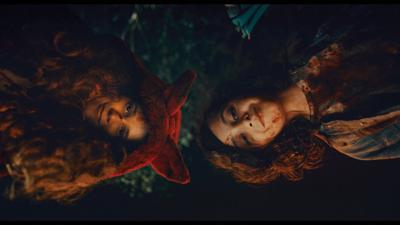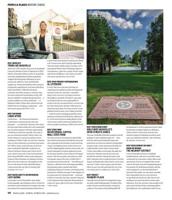Fresh off a multinational tour directing episodes of Chilling Adventures of Sabrina, Pretty Little Liars: Original Sin, Creepshow and Riverdale, former Nashvillian and icon of decency Roxanne Benjamin is about to unleash her second feature film onto an unsuspecting public. A tale of a family vacation intersecting with something cosmic and unspeakable, There’s Something Wrong With the Children is a dark, kicky tear through social anxiety and unearthly terror, filled with grindhouse thrills and arthouse emotions. I had three very immediate responses to the film: I was really impressed with the relationship between the sisters; it has very Debra Hill vibes; and I am in awe of the opening song and however Benjamin snagged it. Also, I wish it wasn’t the winter so I could see this at the drive-in.
Violent and fraught with the sort of emotional confrontations that horror does so well, There’s Something Wrong With the Children is the kind of ice pick in the subconscious that Benjamin has been delivering since she started out producing the first two V/H/S movies. We spoke with her via Zoom in preparation for the film’s upcoming release.
There’s an anecdote from the set of 1978’s Halloween — Jamie Lee Curtis talks about having to have a fear-o-meter to let her know exactly how scared she needed to be in each scene. Did you have to take a similar tack with your young-adult actors?
It’s kind of the same as working with the adult actors. They’re all prepared, but as director, it’s part of my job to let them know where they just came from. Because the schedule is all over the place, and sometimes things change. So it can be a lot to prepare for. But as far as a specific level of evil, we never really had to talk about that; they were just so good at being creepy. One of the things I told them about the way the movie unfolds was, “Pretend you have a sibling that you’re messing with, but you don’t want your parents to know.” It’s the same energy as a younger sibling pulling that “I’m not touching you,” so that they’re the one who gets in trouble and not you. And they got that right away.
Did you have a name for the thing or the phenomenon in the film’s mysterious pit?
No, not really. We came up with sort of an insect language — what’s written in the script is more a sequence of nonsense noises, chittering noises; but what exactly does that mean? So I had the sound designer send me over a bunch of bug noises, and I looked up a bunch of things on YouTube, and then I played them all many times, these clips of bugs and animals. And then on some of the night scenes, I would be making all sorts of weird noises for [actress Alisha Wainwright] to react to. And our animal wrangler, whom we had to have on set every day because Louisiana is filled with venomous snakes, and they are everywhere. So many snakes. I had no idea how many snakes were just always around and chilling within 10 feet of you at any given time in the woods around New Orleans. So we had the snake wrangler every day, and everybody loves the snake wrangler. But on the night scenes when the kids weren’t on set, I’d make noises for Alisha to react to, and the snake wrangler said to me, “You sound exactly like my hyena.” To which I responded, “Cool!”
Louisiana is the Australia of America.
It really is. But the kids were so good at taking the language and making it their own. It’s so funny, the old adage about never working with kids or animals, and I’ve done both now.
Producers Blumhouse have had several different eras of producing up-and-coming films, and I’m wondering how you came to be part of this new incarnation, working in conjunction with Paramount and MGM+?
It’s interesting because a lot of their previous films felt like series, and these films via MGM+ don’t really feel like that. The previous movies all had an umbrella that they fit under [Into the Dark, Welcome to the Blumhouse], and the Hulu ones were holiday-themed, but this batch are each individual films. And I think this has allowed them to be more varied, just in the types of films that they can be. The only limitations were that they had to be something that could be shot in Louisiana and on location, because there aren’t really stages. I think my manager had initially put me up for one of them, and it wasn’t the right one. And then I sent the producers another script of mine, and once they read that they said, “Oh, we have one for you.” The one I had written wouldn’t really work; it was an oceanside piece. But they said, “Oh, you like outdoor stuff,” and pretty much everything I shoot is outdoors, so they said, “Have a look at this one.” And I did, and it was exactly my vibe.
You’ve been very busy in the past few years. In addition to your first feature Body at Brighton Rock, you’ve been directing all over the place on a lot of interesting TV shows.
In a way, they’re like two completely different jobs. In one instance, it’s your own vision and you’re telling a beginning, middle and end. But when you’re tackling TV episodes, it could be the second or fifth season, and you’re just telling a chunk of the story. What’s fun about it, though, is that it’s like playing dress-up — you’re trying on different shooting styles and acting styles, to fit the acting and to approach the specific rhythms of that show. Like, they don’t really do close-ups on Sabrina, or we don’t move the camera so much on other shows. There’s different kinds of aesthetic rules that you’re playing with, and those aren’t necessarily your style, but you learn so much, and you take bits and pieces from them. Plus you get to play with all their toys, and they have so many toys, because TV has so much money. But I get to play with and try things that I wouldn’t necessarily be able to do. On One of Us Is Lying, there was a scene where the characters go skinny-dipping and run down the beach. That’s not a scene I would have written for one of my scripts, and it’s not something I would have shot for one of my projects, but it’s kind of awesome to figure out the mechanics, and the logistics, of shooting something like that. It gives you so much experience in so many different realms.
So how exactly did you get away with the ending of There’s Something Wrong With the Children?
I don’t know. Blumhouse was very good about letting me work with the script. As soon as we got into prep, we did like seven or eight drafts of the script. But that’s normal, and it’s not a case of me taking credit for their script. The DNA of the script is all writers David White and T.J. Cimfel. But that ending — I wrote it out and sent it in, and no one really said anything. And as we moved through the preproduction phase, I asked, “Y’all are really letting me do this?” And they said, “We love it, it’s great.”





